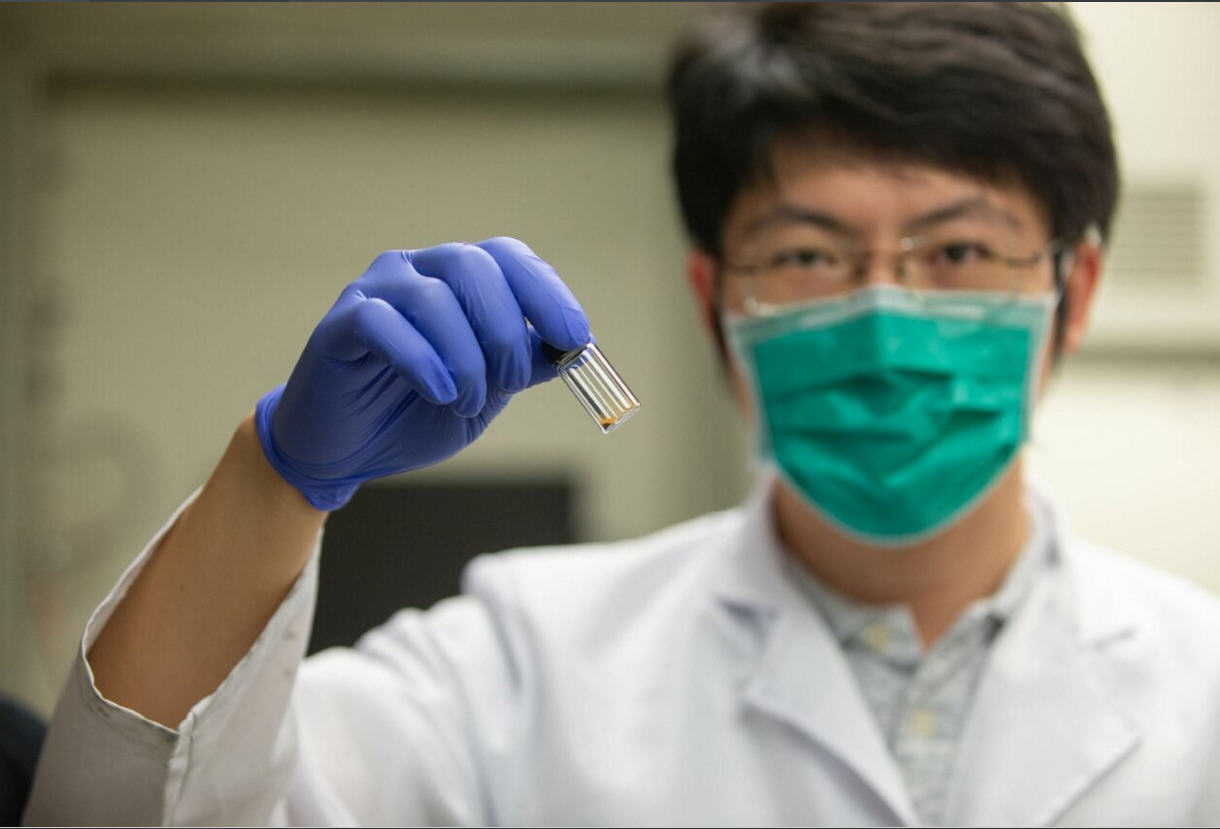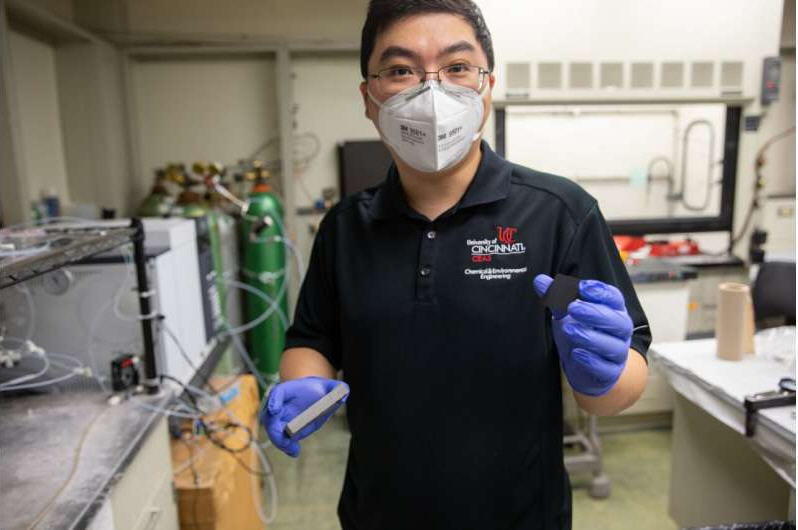博文
美中科学家用二氧化碳反应器制造“火星燃料”
 精选
精选
||
美中科学家用二氧化碳反应器制造“火星燃料”
诸平

Fig. 1 University of Cincinnati chemical engineering student Tianyu Zhang holds up a vial of graphene used as a catalyst to convert carbon dioxide into methane. Credit: Andrew Higley/UC Creative

Fig. 2 An experimental reactor uses graphene quantum dots as a catalyst to convert carbon dioxide into methane. Credit: Andrew Higley/UC Creative

Fig. 3 UC chemical engineering assistant professor Jingjie Wu, left and doctoral student Tianyu Zhang are experimenting with different catalysts to convert carbon dioxide to storable fuel to address climate change. Credit: Andrew Higley/UC Creative

Fig.4 UC chemical engineer Jingjie Wu is experimenting with different catalysts to convert carbon dioxide to fuels such as methane to address climate change. Credit: Andrew Higley/UC Creative
据美国辛辛那提大学(University of Cincinnati,简称UC)2021年9月23日提供的消息,辛辛那提大学的工程师们与中国科学家正在开发将温室气体转化为燃料的新方法(Carbon dioxide reactor makes “Martian fuel”),以应对气候变化,并让宇航员从火星返回地球。
辛辛那提大学工程与应用科学学院(UC College of Engineering and Applied Science)助理教授吴景杰(Jingjie Wu音译)和他的学生们在反应器中使用了一种碳催化剂,将二氧化碳转化为甲烷。这一过程被已故法国化学家保罗·萨巴蒂尔(Paul Sabatier)称为“萨巴蒂尔反应(Sabatier reaction)”,国际空间站(International Space Station)用来清除宇航员呼吸空气中的二氧化碳,并产生火箭燃料,使空间站保持在高轨道上。
但吴景杰的想法要大得多。火星的大气层几乎完全由二氧化碳组成。吴景杰说,宇航员一旦到达火星,就可以制造他们在火星上需要的东西,这样可以节省一半返程所需的燃料。“它就像火星上的加油站。你可以很容易地将二氧化碳泵入这个反应堆,为火箭生产甲烷。”
相关研究结果于2021年9月6日已经在《自然通讯》(Nature Communications)杂志网站发表——Tianyu Zhang, Weitao Li, Kai Huang, Huazhang Guo, Zhengyuan Li, Yanbo Fang, Ram Manohar Yadav, Vesselin Shanov, Pulickel M. Ajayan, Liang Wang, Cheng Lian, Jingjie Wu. Regulation of functional groups on graphene quantum dots directs selective CO2 to CH4 conversion. Nature Communications, 2021, Volume 12, Article number: 5265. DOI: 10.1038/s41467-021-25640-1. Published: 06 September 2021. https://doi.org/10.1038/s41467-021-25640-1.参与此项研究的科学家除了来自美国辛辛那提大学(UC)之外,还有来自中国上海大学纳米化学与纳米物理研究所(Institute of Nanochemistry and Nanobiology, Shanghai University)、中国华东理工大学化学工程学院,化学工程国家重点实验室(State Key Laboratory of Chemical Engineering, School of Chemical Engineering, East China University of Science and Technology)以及美国莱斯大学材料科学与纳米工程系(Department of Materials Science and NanoEngineering, Rice University)的科学家。
吴景杰的化学工程生涯始于研究电动汽车的燃料电池,但大约10年前,他在化学工程实验室开始研究二氧化碳转化。
吴景杰说:“我意识到温室气体将成为社会上的一个大问题,很多国家意识到二氧化碳对我们社会的可持续发展是一个大问题。这就是为什么我认为我们需要实现碳中和的原因。”
要实现到2030年将温室气体污染物减少50%的目标,到2050年实现依赖可再生能源的经济。吴景杰说:“这意味着我们必须回收二氧化碳。”
吴景杰和他的学生,包括上述论文的第一作者、辛辛那提大学博士生张天宇(Tianyu Zhang音译),正在实验不同的催化剂,如石墨烯量子点——只有纳米大的碳层,可以增加甲烷的产量。吴景杰说,这一工艺有望帮助缓解气候变化,而且它在副产品燃料生产方面也有很大的商业优势。
吴景杰说:“与10年前相比,这个过程的生产力提高了100倍。所以你可以想象,进步会越来越快。在未来10年里,我们会有很多初创公司将这项技术商业化。”
吴景杰的学生们不仅使用不同的催化剂来生产甲烷,而且还生产乙烯。乙烯被称为世界上最重要的化学物质,用于制造塑料、橡胶、合成服装和其他产品。博士生张天宇说:“绿色能源将非常重要。在未来,它将代表一个巨大的市场。所以我想对其进行研究。”
吴景杰说,当结合太阳能或风能等可再生能源时,用二氧化碳合成燃料在商业上变得更加可行。“现在我们有多余的绿色能源,我们只是把它们扔掉。我们可以将这些多余的可再生能源储存在化学品中。”
此工艺可用于可产生数吨二氧化碳的发电厂。而且它是高效的,因为转换可以发生在产生多余二氧化碳的地方。吴景杰说,利用二氧化碳生产燃料的进步使他更有信心,人类将会在他的有生之年踏上火星。他说:“现在,如果你想从火星回来,你需要带两倍多的燃料,这非常重。在未来,你将需要其他燃料。所以我们可以由二氧化碳生产甲醇并用它们来生产其他下游物质。也许有朝一日我们可以在火星上生活。”
火星有望成为人类探索宇宙的加油站。
上述介绍,仅供参考。欲了解更多信息,敬请注意浏览原文或者相关报道。
A catalyst system with dedicated selectivity toward a single hydrocarbon or oxygenate product is essential to enable the industrial application of electrochemical conversion of CO2 to high-value chemicals. Cu is the only known metal catalyst that can convert CO2 to high-order hydrocarbons and oxygenates. However, the Cu-based catalysts suffer from diverse selectivity. Here, we report that the functionalized graphene quantum dots can direct CO2 to CH4 conversion with simultaneous high selectivity and production rate. The electron-donating groups facilitate the yield of CH4 from CO2 electro-reduction while electron-withdrawing groups suppress CO2 electro-reduction. The yield of CH4 on electron-donating group functionalized graphene quantum dots is positively correlated to the electron-donating ability and content of electron-donating group. The graphene quantum dots functionalized by either –OH or –NH2 functional group could achieve Faradaic efficiency of 70.0% for CH4 at −200 mA cm−2 partial current density of CH4. The superior yield of CH4 on electron-donating group- over the electron-withdrawing group-functionalized graphene quantum dots possibly originates from the maintenance of higher charge density of potential active sites (neighboring C or N) and the interaction between the electron-donating group and key intermediates. This work provides insight into the design of active carbon catalysts at the molecular scale for the CO2 electro-reduction.
https://blog.sciencenet.cn/blog-212210-1305762.html
上一篇:人人可制无电池电子设备,减少废电池对环境的污染
下一篇:中国科学家报道了由二氧化碳合成的淀粉